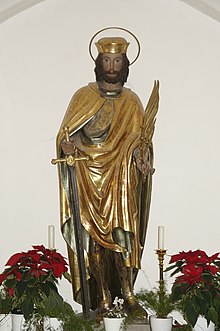Pope Caius, also called Gaius, was the bishop of Rome from 17 December 283 to his death in 296. Little information on Caius is available except that given by the Liber Pontificalis, which relies on a legendary account of the martyrdom of Susanna of Rome for its information. According to legend, Caius baptized the men and women who had been converted by Tiburtius and Castulus. His legend states that Caius took refuge in the catacombs of Rome and died a martyr.
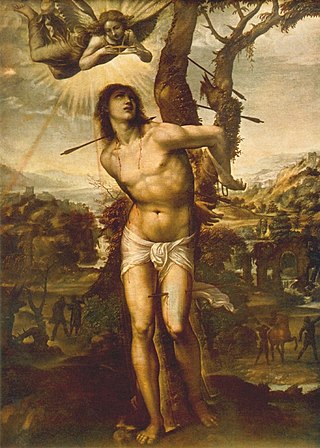
Sebastian was an early Christian saint and martyr. According to traditional belief, he was killed during the Diocletianic Persecution of Christians. He was initially tied to a post or tree and shot with arrows, though this did not kill him. He was, according to tradition, rescued and healed by Irene of Rome, which became a popular subject in 17th-century painting. In all versions of the story, shortly after his recovery he went to Diocletian to warn him about his sins, and as a result was clubbed to death. He is venerated in the Catholic Church and the Orthodox Church.

Pancras was a Roman citizen who converted to Christianity and was beheaded for his faith at the age of fourteen, around the year 304. His name is Greek (Πανκράτιος) and means "the one that holds everything".

Cosmas and Damian were two Arab physicians and early Christian martyrs. They practised their profession in the seaport of Aegeae, then in the Roman province of Cilicia.

Saint Anastasia is a Christian saint and martyr who died at Sirmium in the Roman province of Pannonia Secunda. In the Eastern Orthodox Church, she is venerated as St. Anastasia the Pharmakolytria, i.e. "Deliverer from Potions". This epithet is also translated as "One who Cures (Wounds)" in Lampe's A Patristic Greek Lexicon.
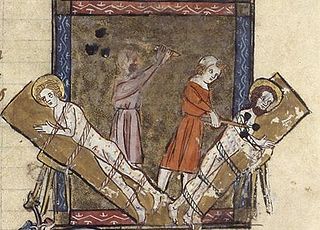
Gervasius and Protasius are venerated as Christian martyrs, probably of the 2nd century. They are the patron saints of Milan and of haymakers and are invoked for the discovery of thieves. Their feast day in the Latin Rite of the Catholic Church is 19 June, the day marking the translation of their relics. In the Eastern Orthodox Church and in the Eastern Rites of the Catholic Church, their feast takes place on 14 October (O.S.)/24 October (N.S.), the traditional day of their death. In Christian iconography their emblems are the scourge, the club and the sword.

The Four Crowned Martyrs or Four Holy Crowned Ones were nine individuals who are venerated as martyrs and saints of Early Christianity. The nine saints are divided into two groups:
- Severus, Severian(us), Carpophorus (Carpoforus), Victorinus
- Claudius, Castorius, Symphorian (Simpronian), Nicostratus, and Simplicius

Mark and Marcellian are martyrs venerated as saints by the Roman Catholic Church and the Eastern Orthodox Church. Their cult is sometimes associated with that of Saints Tranquillinus, Martia, Nicostratus, Zoe, Castulus, and Tiburtius, though not in the official liturgical books of the Church, which mention only Mark and Marcellianus among the saints for 18 June. Their mention in the General Roman Calendar on that date from before the time of the Tridentine calendar was removed in the 1969 revision, because nothing is known about them except their names, the fact of their martyrdom, and that they were buried on 18 June in the cemetery of Santa Balbina on the Via Ardeatina.

Tiburtius, according to Christian legend, was a Christian martyr and saint. His feast day is 11 August which is the same as Saint Susanna. The two were not related, but are sometimes associated because they are venerated on the same day.
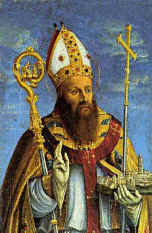
Saint Domnius was a Bishop of Salona around the year 300, and is venerated as the patron of the nearby city of Split in modern Croatia. Salona was a large Roman city serving as capital of the Province of Dalmatia. Saint Domnius was martyred with seven other Christians in the persecutions of the Emperor Diocletian. He was born in Antioch, in modern-day Turkey but historically in Syria, and beheaded in 304 at Salona.

Saints Marcellinus and Peter are venerated within the Catholic Church as martyrs who were beheaded. Hagiographies place them in 4th century Rome. They are generally represented as men in middle age, with tonsures and palms of martyrdom; sometimes they hold a crown each.

Saint Irene of Rome was a Christian woman in the Roman Empire during the reign of Diocletian. She was the wife of Saint Castulus. According to Christian legend, she attended to Saint Sebastian after he was wounded by Mauretanian archers.

Quirinus of Neuss, sometimes called Quirinus of Rome is venerated as a martyr and saint of the Catholic and Eastern Orthodox churches. His cult was centred at Neuss in Germany, though he was a Roman martyr.

Eleutherius, also written as Eleutherus, Eleuterus and Eleftherios; sometimes called Liberalis or Liberator, the former transliterations and the latter translations of his and his mother Antia are venerated as Christian saints and martyrs in Greece and Albania.

Florinus of Remüs, also known as Florin, Florian of Chur, Florinus of Matsch, and Florinus of Vinschgau, is venerated as a saint in the Catholic Church, particularly in the dioceses of Chur, Bolzano-Brixen, Vaduz, and in the Rhineland.

Vigilius of Trent is venerated as the patron saint and bishop of Trent. He should not be confused with the pope of the same name.

Aurea of Ostia is venerated as the patron saint of Ostia.

Hans Leinberger, sometimes given as Lemberger was a Late Gothic sculptor from Altbayern, who worked in wood, metal and stone.

Justin the Confessor was a Christian martyr in the Roman Empire. He is honoured as a saint by the Roman Catholic Church.
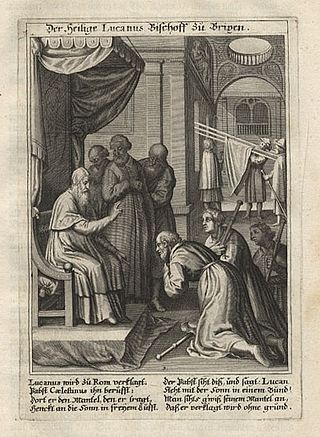
Saint Lucanus of Sabiona or Lucanus of Säben, is a Roman Catholic saint of the fifth century, associated with the Dolomites and the Tyrol.
